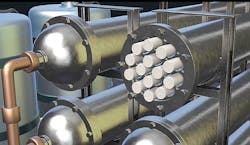Setting the course for a circular economy and a sustainable water future
Water is a precious resource and as access to it becomes constrained — whether by quantity or quality — industrial users are being challenged to optimize both their water usage and their wastewater generation, striving ultimately for zero waste.
Circular Economy
In the circular economy concept, intentionally minimizing (or even eliminating) waste by keeping resources in use for as long as possible is a key component. It’s a big departure from the linear way of thinking that has guided us since the industrial revolution. But in nature, it’s business as usual.
“Biology has evolved over 3.8 billion years and as a result it’s come up with some extremely refined solutions, including many of the kinds of challenges we face in the water industry,” said Michael Pawlyn, an architect with biomimicry-focused design firm Exploration Architecture.
In biomimicry, biology is used as a source of inspiration for innovations that meet human needs, he explained. Nature has already found solutions for many of the challenges we face — how to harvest water in dry areas, how to filter water, how to extract nutrients from water. “For pretty much all of those, you can find equivalents in biology that you can learn from,” he noted.
Pawlyn, who is considered a foremost expert on biomimicry, said he’s been studying circular economy models and how they can be applied to factories, industrial processes, and even entire cities to allow all resources and nutrients to be stewarded within closed loop cycles. “Because that’s ultimately where we have to get to,” he said. “We know that.”Mature ecosystems have a lot to teach us about the way ecosystem models work. “You’ve got a lot of interconnected and interdependent species, and there’s no such thing as waste,” he said. All underutilized resources become useful for something else in that system. “And we’ve applied that to projects such as a zero-waste textiles factory,” he noted. “By rethinking all of the things that were going into the water streams, we were able to redesign that system to allow for almost completely closed-loop — and certainly zero-liquid — discharge.”
While biomimicry holds tremendous promise for achieving a circular economy, we still have far to go, Pawlyn said, particularly with regard to economic barriers. As an example, he pointed to nutrient recovery. “It’s perfectly possible to recover all the nutrients from wastewater; it’s not technically problematic.” But, he said, “you find that you get into competition with the fertilizer industry. Now at the moment, the fertilizer industry externalizes all sorts of costs, principally in terms of greenhouse gas emissions and so on. If the fertilizer industry were forced to internalize all of those externalities then, immediately, I think we would see more of these biologically inspired solutions much more viable and the take-up would accelerate.”
Hidden Costs of Water
As industries work to understand and control their water consumption, it is going to be critical for them to consider not only the tangible costs of water but the intangible ones as well.
“We always talk about the cost of water per meter cubed, and everybody is very focused on life cycle cost or capital cost,” said Devesh Sharma, managing director of Aquatech. “Sometimes that’s okay; it’s a good start. But it’s really the tip of the iceberg when it comes to the real impact [of water] on overall operation.”
These hidden costs of water can have very noticeable impacts and there are several risks to consider. One of the most important, however, is downtime risk. “Are you capturing the risk related to the water system going down? If the system goes down, what’s going to happen to the plant? Is there enough storage or is the plant going to go down? And if the plant goes down, what’s the cost of that?” he said. “That has to be looked at when looking at the resiliency of the water system.” As Sharma likes to say: the most expensive water is no water.
The key to ensuring a holistic water management strategy, Sharma said, is aligning the corporate objectives to the plant objectives. “Sometimes the corporate objectives are more strategic, they are more long-term thinking,” he noted, “while the focus of the plant is on the short-term balance sheet and P&L of the plant.” The trick, he said, is to find a good, happy medium between the two.
Corporate Water Management Strategy
When it comes to the current state of corporate water management, the landscape is evolving, according to Emilio Tenuta, vice president of corporate sustainability for Ecolab. His company, in conjunction with S&P Trucost, conducted a survey to engage the private sector on water management objectives. “We found out from 86 companies with revenues of over a billion [dollars] that there’s good news and bad news,” he said. The good news is that 88 percent of those that responded affirmed that water is a priority over the next two years. “However, the bad news is that 44 percent of them didn’t have a plan to get it done,” he said.
The challenges centered around four key areas, what Tenuta referred to as design criteria.
1. Is there a site management plan where there’s accountability by the site leaders that they really “own” the water management plan?
2. What’s the water use management strategy for the facility?
3. Was target-setting meaningful to the local site, not just to corporate?
4. Is water stewardship being considered, not only in terms of what’s happening around the fence line but also as a shared resource that is depended upon by other stakeholders?
Analysis of the survey data revealed something else: companies are doing a good job of setting corporate targets but they aren’t so good at translating them down to the local level, echoing Sharma’s earlier sentiments.
In partnership with S&P Trucost, Ecolab created a complement to its popular Water Risk Monetizer called the Ecolab Smart Water Navigator. “The idea was, how do we get at those resource constraints where goals are being set but not transcending down to the local level?” he said. The Smart Water Navigator, which is a free, publicly available tool, allows the user to perform a 13-question self-assessment. It allows the user to determine, at a site level, where they are in a “water maturity curve.” “We feel that companies and sites are on a journey to become water smart,” explained Tenuta. “The water maturity curve allows you to understand where you’re starting from because you can’t improve unless you know that first.” Then, based on the industry, the Smart Water Navigator provides an industry-specific guide that systematically takes the user through the steps needed to become water smart.
Filtration at the Molecular Level
In the quest to use — and reuse — water efficiently, technologies that can balance water and energy footprints will be critical. Membranes play a very important role, according to Susan MacKay, CEO of high-purity filtration manufacturer Cerahelix. In the circular economy, she observed, you’re trying to reclaim nearly all the water that goes into a production facility. “So, you’re using water to make products and to manufacture, and you want to be able to reuse that water and recycle it through the plant — nearly 100 percent of it,” she said. “What you need are technologies that can help purify the water as it goes through the plant but also not use a lot of energy to do that.”
While membranes aren’t new per se, MacKay’s company has added a twist to its ceramic membranes, literally. It uses strands of DNA as a template for the pore structure. “DNA is very unique compared to other organic materials you can use to template,” she explained. The double helix makes it very stiff, meaning that it can remain straight over the long length of a DNA strand. “And that allows us to form straight pores and it keeps the pore size distribution narrow,” she said.
Once the DNA is coated, the filter is put into a kiln. “We burn off the DNA and we have a very hard ceramic filter that has those very fine pores in the surface.”
In fact, the technique can achieve pore sizes smaller than a nanometer. “When you get below a nanometer in the pore, you’re doing what’s called molecular separations,” she explained. A single pass through the filter can reduce BOD and COD more than 95 percent.
It’s ideally suited for water-intensive industries striving to be more sustainable. Recently, Cerahelix announced a contract to treat wastewater for a Fortune 50 personal care products manufacturer. “We’ll be treating up to 100,000 gallons per day of effluent [for reuse],” she said. “They’re using it in a new sustainable manufacturing facility they’re bringing online and we’re a critical piece in that.”
Conclusion
Across the globe, manufacturers endeavoring to become more sustainable will seek to efficiently manage both their water resources and their energy resources. Through innovation, technology, and thoughtful water management strategy, achieving a circular economy may be closer than we think. IWW
About the Author: Angela Godwin is chief editor of Endeavor Business Media’s Water Group, which includes WaterWorld and Industrial WaterWorld magazines. She can be contacted at [email protected].
About the Author
Angela Godwin
Editorial Director
Angela Godwin is the editorial director for Endeavor Business Media's Process/Water Group. With over 25 years of editorial experience, she currently oversees editorial direction for several leading brands, including WaterWorld, Water Technology, Stormwater, Processing, and P.I. Process Instrumentation magazines. She also created the popular water industry interview series The Drop. She is a graduate of the University of Massachusetts-Amherst.


